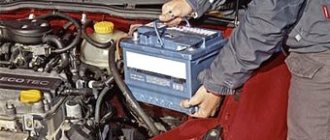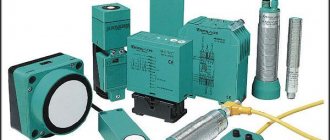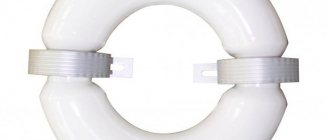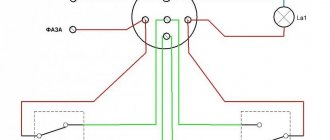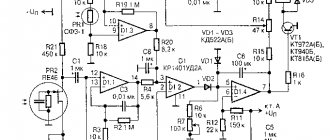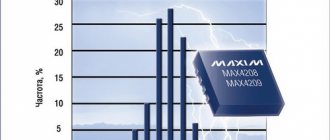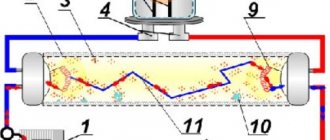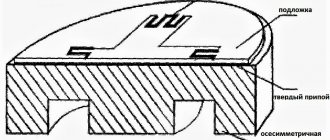How does an outdoor photo sensor work?
If you install a light sensor to turn on the light above the entrance to the entrance, it will work on the same principle as a regular lamp with a motion sensor. The operation of the lamp is controlled by a sensor that senses changes in the movement of objects in the control zone. Or a photosensitive element that responds to changes in light flux.
The main element of such a device is a sensitive photocell, which is located on the board and can change its properties.
The photocell is implemented on the basis of a photoresistor. As long as the level of light falling on its surface is sufficient, the power circuit is open. Twilight thickens, and the parameters of the photocell change, causing the circuit to close. The lamp in front of the entrance turns on. In the morning the reverse ceremony takes place. As soon as the light level rises to a predetermined value, the circuit opens and the lamp goes out. This is the basic principle of operation of a photo relay.
If you additionally install a motion detector, the light will turn on exactly at the moment when the sensor detects movement.
Device Description
A light sensor, also known as a photo relay and light sensor, and a twilight switch are installed between the power source and the consumer in the form of some kind of lighting fixture. Depending on the installation location, the device can be externally presented in the form of an automatic device (on a DIN rail) with a remote sensitive element built into a separate housing or into a lamp.
Photo relay
In fact, all sensors have a common structure and operating principle. The first working element is a photosensitive photodiode, phototransistor or photoresistor (it costs less and is more often used in the production of sensors). All of them, to varying degrees, have the attractive ability to change resistance depending on the level of light. The lighter, the lower the indicator.
Photocells
With the onset of extreme darkness, the photoresistor sends a signal to the amplifier. The circuit has a relay that closes it. As a result, current flows to the lamp. When the sun rises, the circuit opens.
The sensitivity threshold can be controlled using the built-in regulator, if available. You can install it by experimenting or gradually. The latter is considered the most practical. First they set the minimum, then, gradually increasing, they reach the desired level.
Pros and cons of using an outdoor photo relay
The main advantage of the daylight sensor is tangible energy savings. The undoubted advantages of systems using photocells are:
- The device operates at low currents.
- Instant on/off.
- High performance.
- There are no rubbing mechanical parts, which increases the durability of the device.
- Long period of operation.
But it should be borne in mind that the device is not designed for use in extreme conditions. Therefore, you should carefully monitor its tightness. Ingress of moisture can, if not completely disable the sensor, damage it by causing oxidation of the relay contacts.
A dirty and dusty sensor will also not function properly. The entire device must be kept clean at all times.
Where can I buy
You can purchase lighting control equipment either in a specialized store or online in an online store. In the second case, the budget option for purchasing products on the Aliexpress website deserves special attention. For some video cameras there is an option for shipment from a warehouse in the Russian Federation; they can be received as quickly as possible; to do this, when ordering, select “Delivery from the Russian Federation”:
| Photo relay with automatic on/off | Photosensitive module for Arduino | Automatic control module for light switching |
| Street lamp with built-in light sensor | Adjustable photoresistor switch | Wall switch for lighting control |
Varieties
Based on the type of sensors used, they are divided into several groups:
- Infrared. They are triggered by heat in the field of operation of the sensor. Since domestic animals, in addition to humans, are warm-blooded, infrared detectors can also react to them.
- Acoustic. React to noise. If the doors open with a creak, or there are loud footsteps, the sensor will trigger.
- Microwave. Active type sensors. They themselves form waves in the microwave range and track their return back. If there is a difference from a moving object, the electrical circuits are closed/opened.
- Ultrasonic. The operating principle is similar to microwave sensors, but they are rarely used in practice. Pets may react inadequately to ultrasound.
- Combined. Several types of motion detection can be combined in one lighting device. More reliable systems, but also more expensive.
- Astronomical timer. New generation relays. It also controls the operation of lighting devices, but is based on a different control principle. The microcomputer of the astro-timer contains a program with data on the time of movement of the sun in different regions of the planet. In order to set up the device, you need to enter the GPS data of your locality and the current date and time into the device. Based on these key settings, it will automatically determine when it's time to turn on the lights. If false alarms are possible with a photo relay, then the astro timer does not have such errors. It works in any weather.
Typically, an infrared light sensor is used for a street lamp, as it has a number of advantages:
- inexpensive;
- with a large range;
- can be easily adjusted to suit your preferences.
Street or staircase detectors predominantly use either ultrasonic or microwave detectors. Capable of reacting at a sufficiently large distance from the light source. Microwave - can react even if the person is still behind the barrier.
There is also a classification of automatic lighting devices for street lighting according to the type of photo relay design.
- All lamp control elements are located in one housing. This design is more voluminous, but also quite convenient - there are no unnecessary wires. You just need to attach it next to the lamp.
- The “day” sensor itself is mounted outside, and the control relay with the lamp is located in a separate panel inside the room. Thus, all elements of street lighting regulation are thoroughly protected from weather disasters.
The sensitivity of the devices can be adjusted. The regulators are located at the bottom of the case and are signed with “+” and “—” signs.
It is better to work with adjusting the light sensor when it gets dark and when it is installed and connected to the network.
By turning the screw towards the minus sign, the sensor loses its sensitivity. And the relay will start to operate only in complete darkness. And accordingly, by turning towards the plus, the sensitivity increases.
When all the manipulations are completed and the result of the work is positive, the photo relay setup will be completed.
In addition to such adjustable photo relays, there are the same devices, but supplemented with a motion detector. The flashlight will not turn on in the dark until the detector reacts to the movement of a person in its area of influence.
Is there an alternative
In some areas, installation of a photo relay is difficult due to the terrain or the abundance of trees. In such cases, you can use modern developments, which are tied not to the lighting level, but to other data. Such a device is called an astronomical timer. Thanks to the precise timing of the earth's movement around the sun and its axis, it is easy to predict the time of sunrise and sunset in a particular area. This is exactly what this device does. When you turn it on for the first time, you will need to indicate your location using coordinates, as well as the exact time. Thanks to the built-in firmware, the device will turn street lighting on and off.
The advantage of such a solution over a photo relay is its independence from what is happening on the street. In rainy weather, when there is little light outside, the photo relay may mistakenly determine that it is twilight and it is necessary to turn on the lighting. The astro timer is oriented by time and coordinates, so it is not affected by such changes. If the photo relay is dirty or crushed by snow, then there may also be false alarms. For a timer that works by coordinates, there is no need to allocate a special place for installation. It can be placed in any convenient place in the house. Some models allow the start delay to be adjusted. The only downside may be the price, but you have to pay for quality.
Note! Instead of a photo relay, you can use a regular timer. It will supply power to the lighting at the specified time. It is not as convenient as a photo relay, but it can also help out quite well.
On a note
When choosing a street light detector, it is worth considering some points:
- dimensions of the local area;
- For suburban areas, relays with an adjustment function for triggering are recommended. Such light sensors are easy to configure yourself;
- adjustment will require time and minimal skills;
- a light sensor with a timer will allow you to more accurately adjust the on/off by programming the response time;
- It is better to equip an outdoor photo sensor with a limiter to protect it from light from window and lampposts. You can make such a light visor yourself, for example, from a piece of plastic pipe of a suitable diameter;
- For street lighting, it is better to use LED or fluorescent lamps rather than ordinary incandescent lamps. This way you can save on your electricity bills. In addition, the sensor itself can be selected with a lower throughput, and therefore cheaper;
- Select the installation location according to the attached instructions.
Before purchasing a device, it is important to choose the viewing angle in the horizontal plane. If the lighting area can be approached from any course of movement, relays with a viewing angle from 180° to 360° are needed:
- Wall mounted with a visibility angle of 180°.
- Pole with a 360° visibility angle.
The installation height is also important. The main condition when a photo relay works is that there are no “dead zones”. Household appliances are characterized by a narrow vertical detection zone - from 15° to 20°.
In order for motion sensors to work without breakdowns, you need to know that they are designed for a certain load. Just before purchasing, calculate the total power of the connected lamps that such a device will control.
Specifications
Light sensors for street lighting have technical characteristics that determine the possibility of their operation in certain conditions. For a photo relay, these parameters are:
- Supply voltage. 220 V models are installed in the apartment. If the installed system includes 12–36 V devices, a low-order circuit must be provided. This voltage is necessary to start the contactors of magnetic starters;
- Maximum permissible current. It is important when connecting devices operating from 220 V. In this case, an electric current passes through the contacts of the photo relay, intended to ensure the operation of the light source;
- The temperature at which the device can be operated. Outdoor models must remain operational over a wide temperature range. They must cope with the task in frost and extreme heat;
- Degree of protection. The outdoor device must have sufficient protection against moisture and water;
- Dimensions and weight. They are of fundamental importance when space is limited at the installation site.
Installation and connection
In order for the photo relay to work correctly, it is necessary to accurately select the installation location. To do this, it is important to comply with some conditions:
- The elements of the photo sensor must be exposed to sunlight.
- Do not place operating lighting fixtures near the sensor at night.
- Protect the photocell from the headlights of passing cars.
- Place the sensor at an accessible height for periodic maintenance.
- Before purchasing, you need to choose what the device will be powered from: 220 V or 12 V.
- Since the relay will operate outdoors, it is better to choose a protection class of at least IP44. But in any case, the higher it is, the better the performance of the device.
- It is necessary to observe the temperature ranges of the sensor operation specified by the manufacturer.
- If you plan to connect not one, but several lamps, the photo relay must have a power reserve. This will help prevent overloading and damage to the device.
If you are going to connect a light sensor with your own hands, then you need to know that there are three wires: phase and zero for turning on the relay, connecting phase for connecting the lamp.
The wires are connected in a sealed outdoor junction box. For one luminaire, the box can be installed next to the relay. If there are several lamps, it is recommended to connect them through a starter.
In the standard version, the switching wires have different colors: one is always red. The other two are blue and black.
- Red connects either lighting devices or a motion detector.
- Blue - connection to the zero phase is in progress.
- Black - the phase is connected.
If the color of the wires is different, it is recommended to carefully study the connection instructions supplied with the sensor.
The light control device for the adjacent area works automatically. But there is a button to switch to manual mode.
We also recommend that you learn how to configure a motion sensor before commissioning for use with a light sensor in order to improve the quality and accuracy of the device.
What to choose
Choosing a photo relay for lighting is based on specific needs or a project. To do this, several factors must be taken into account:
- total lighting power;
- position of the area for lighting;
- lighting voltage;
- sensor installation location;
- lighting operating hours;
- presence of a surveillance system;
- the need for additional modules.
Next to each item on this list you must make the required notes. This will allow you to quickly analyze the characteristics of the photo relays discussed above. In some cases, it will be necessary to install several light sensors.
Connection diagrams
So, the main function of the light sensor is to supply voltage to street lighting equipment when it starts to get dark and turn it off at dawn. It's like a switch, but controlled by a photosensitive element.
A simple external connection diagram is obtained when the phase is placed in a break with the photo relay and lighting device.
In order for current to flow through the light sensor, a working zero must also be connected to it.
In order to be able to control devices of different power, the photosensor is selected according to the power of the connected load. But here you need to understand how the device works. As the power of the device being switched on increases, the price of such devices also increases.
To circumvent this point, a conventional magnetic starter is included in the circuit. It is designed specifically for network management. And to control the starter, a photosensor with a small connected load is added to the circuit. That is, the sensor no longer turns on the street lights themselves, but supplies a small current to the control magnetic starter. But you can already connect a powerful load to it.
If the photo relay is not enough, then the control functionality can be expanded by adding a timer and motion sensor to the circuit. They are installed in series after the light sensor. What to install first - a motion sensor or a timer does not play a special role in this scheme.
If you don’t plan to install a motion detector or timer, you don’t have to install them without changing the circuit - it will still work.
We recommend reading: step-by-step instructions on how to connect a photo relay.
Application benefits
The advantage of using a photo relay is difficult to overestimate. This not only saves time, but also money. Some buildings require façade lighting to be turned on in the evening to create a unique spatial effect. Everyone likes it when street lights turn on in a timely manner. Photo relays can be used in conjunction with video surveillance systems. Some types of the latter require good light for a high-quality picture. Photo relays are used not only for lighting. In some cases, photo sensors are used for irrigation systems. As soon as the sun goes down, the irrigation pumps turn on. This is done in such a way that the scorching sun does not scorch the foliage of the plants.
If you constantly monitor your electricity bills, then you will definitely see a decrease in the number after you start using the photo sensor. Manufacturers are trying to simplify the assembly and connection of the light sensor. This means that for its installation there is no need to involve a professional, and everything can be done independently. The photo sensor makes it possible to increase the security of your own home. Houses with poor lighting are often targeted for burglary. The photo relay will work even when no one is at home and create the effect of the presence of the owners. For the most part, photo relays correspond to the declared characteristics, so there is no need to talk about shortcomings. There may only be differences in models.
Known modifications of street lighting sensors
On the modern market there is a large selection of photo sensors, both imported and domestically produced. The variations in choice are very large:
- according to lighting conditions;
- types of lighting;
- according to the power of connected lighting devices;
- advanced features.
Photo relay FR-601 and FR-602
For domestic needs, single-phase models FR-601 and a more advanced modification FR-602 from the IEK company are in demand. Both are reliable enough for lighting and easy to connect. They are almost identical in functionality, powered by household current with the same voltage and frequency. Power - 0.5 W.
Also with the same protection class IP44, which provides protection from dust and moisture.
Differences in the cross-section of connected wires:
- FR-601 1.5 square;
- FR-602 2.5 mm².
Therefore, there are differences in load current: the first one has 10 A, the second one has 20 A.
Both have built-in photocells with adjustment from 0 to 50 lux in 5 lux intervals.
The main application is outdoor lighting for cottages and private houses when night falls.
High power sensors: photo relay FR-7 and FR-7E
To regulate lighting near the entrance, more powerful modifications are used on city streets. Which are capable of operating from an alternating current network of 220 V and a current of up to 5 amperes.
Such devices include photocells FR-7 and FR-7e.
These models have a number of distinctive features:
- high level of required power;
- low protection class IP40, designed mainly for protection against moisture;
- there is no protection for the construction resistor;
- open type connection terminals.
